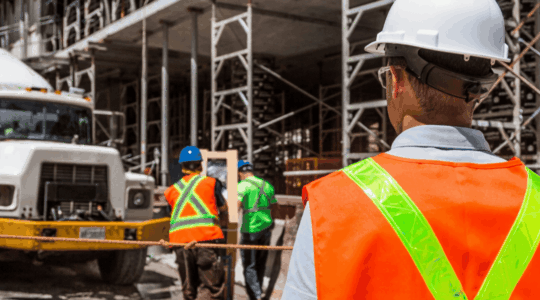Construction
Trenching Safety and Excavation Safety [Checklist]
On average, two workers are killed every month in trench collapses.
April 4, 2023
Last summer, a family-owned construction services contracting company failed to comply with required trench safeguards, according to the Occupational Safety and Health Administration (OSHA), and an employee was killed when an eight-foot-deep trench collapsed. OSHA cited the contractor for three willful violations and proposed $375K in penalties. Meanwhile, the worker’s family and friends were left to grieve.
Another contractor that “willfully” failed to use legally required trench protection systems is facing manslaughter charges for a worker's 2021 trench collapse death. The company went out of business, and, once again, family and friends were left to grieve.
Last year, OSHA reported that 39 trenching and excavation workers died in collapses or cave-ins. By instituting safe work practices and procedures, employers can prevent needless worksite injuries and deaths—and protect the financial and reputational health of their companies, too.
Defining an Excavation and a Trench
An excavation is any man-made cut, cavity, trench or depression in the earth’s surface formed by earth removal. Trench (trench excavation) refers to a narrow excavation (in relation to its length) made below the surface of the ground. In general, the depth is greater than the width, but the width of a trench (measured at the bottom) is not greater than 15 feet (4.6 meters).
Dangers of Trenching and Excavation
Cave-ins pose the greatest risk and are much more likely to result in worker fatalities than any other excavation-related accidents. Other potential hazards include falls, falling loads, hazardous atmospheres and incidents involving mobile equipment. One cubic yard of soil can weigh as much as a car. An unprotected trench is an early grave. Do not enter an unprotected trench.
Trenching Safety Measures
Trenches 5 feet (1.5 meters) deep or greater require a protective system unless the excavation is made entirely in stable rock. If the trench is less than 5 feet deep, a competent person may determine that a protective system is not required.
Trenches 20 feet (6.1 meters) deep or greater require that the protective system be designed by a registered professional engineer or be based on tabulated data prepared and/or approved by a registered professional engineer.
Daily Inspections
By OSHA standards, trenches need to be inspected daily before work begins or whenever conditions change by a competent person to ensure the elimination of excavation hazards. A competent person is an individual who is capable of identifying existing and predictable hazards or working conditions that are hazardous, unsanitary, or dangerous to workers, soil types and protective systems required, and who is authorized to take prompt corrective measures to eliminate these hazards and conditions. Workers should consult with the project supervisor at the beginning of each shift to ensure any trenches they will be working in have been properly inspected and are safe for entry.
Access and Egress
OSHA standards require safe access and egress to all excavations, including ladders, steps, ramps or other safe means of exit for employees working in trench excavations 4 feet (1.22 meters) or deeper. These devices must always be within 25 feet (7.6 meters) of employees.
General Trenching Safety and Excavation Safety Rules
Follow these trenching safety rules to help prevent serious accidents:
- Keep heavy equipment away from trench edges.
- Identify and address other sources that might affect trench stability.
- Keep excavated soil (spoils) and other materials at least 2 feet (0.6 meters) from trench edges.
- Know where underground utilities are located before digging.
- Test for atmospheric hazards such as low oxygen, hazardous fumes and toxic gases when trenches are greater than 4 feet deep.
- Inspect trenches at the start of each shift.
- Inspect trenches following a rainstorm or other water intrusion.
- Do not work under suspended or raised loads and materials.
- Inspect trenches after any occurrence that could have changed conditions in the trench.
- Ensure that personnel wear high visibility or other suitable clothing when exposed to vehicular traffic.
Protective Systems
Consider the following methods for ensuring worker safety:
- Benching. This is a method of protecting workers from cave-ins by excavating the sides of an excavation to form one or a series of horizontal levels or steps, usually with vertical or near vertical surfaces between levels. Benching cannot be done in Type C soil.
- Sloping. This method involves cutting back the trench wall at an angle inclined away from the excavation.
- Shoring. This method requires installing aluminum hydraulic or other types of supports to prevent soil movement and cave-ins.
- Shielding. This method protects workers by using trench boxes or other types of supports to prevent soil cave-ins. Designing a protective system can be complex because you must consider many factors: soil classification, depth of cut, water content of soil, changes caused by weather or climate, surcharge loads (e.g., spoil, other materials to be used in the trench) and other operations in the vicinity.
Trenching Safety Checklist
Download this checklist to learn best practices for preventing trenching injuries and fatalities where trenches are less than 20 feet deep. To learn more about how Hylant helps construction organizations protect their people and their bottom line or to find an advisor, click here.
Related Reading: 9 Ways to Improve Construction Site Safety
The above information does not constitute advice. Always contact your insurance broker or trusted advisor for insurance-related questions.


